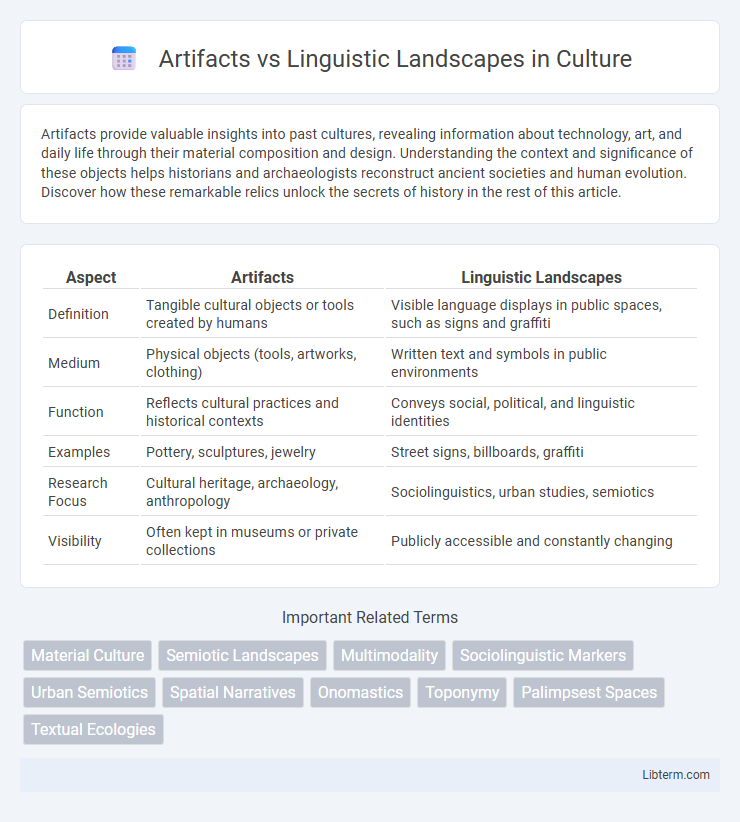Artifacts provide valuable insights into past cultures, revealing information about technology, art, and daily life through their material composition and design. Understanding the context and significance of these objects helps historians and archaeologists reconstruct ancient societies and human evolution. Discover how these remarkable relics unlock the secrets of history in the rest of this article.
Table of Comparison
| Aspect | Artifacts | Linguistic Landscapes |
|---|---|---|
| Definition | Tangible cultural objects or tools created by humans | Visible language displays in public spaces, such as signs and graffiti |
| Medium | Physical objects (tools, artworks, clothing) | Written text and symbols in public environments |
| Function | Reflects cultural practices and historical contexts | Conveys social, political, and linguistic identities |
| Examples | Pottery, sculptures, jewelry | Street signs, billboards, graffiti |
| Research Focus | Cultural heritage, archaeology, anthropology | Sociolinguistics, urban studies, semiotics |
| Visibility | Often kept in museums or private collections | Publicly accessible and constantly changing |
Introduction to Artifacts and Linguistic Landscapes
Artifacts represent tangible cultural objects that convey historical, social, and linguistic information through physical form and design, serving as material evidence of human activity. Linguistic landscapes encapsulate the visible display of language in public spaces, such as signs, advertisements, and graffiti, reflecting sociolinguistic dynamics and language policy in a given community. Understanding these components aids in analyzing how language and culture intersect in everyday environments and heritage documentation.
Defining Artifacts: Meaning and Significance
Artifacts serve as tangible reflections of cultural identity and historical context, embodying the material culture that shapes societal narratives. Their meaning extends beyond physical form to encompass symbolism, social function, and the values imbued by their creators and users. Understanding artifacts involves analyzing material composition, usage, and semiotic significance to uncover deeper cultural and historical insights.
Understanding Linguistic Landscapes
Understanding linguistic landscapes involves analyzing public signage, advertisements, and graffiti to interpret language use and social dynamics in a specific area. These visual texts reflect power relations, identity, and multilingual practices within communities, providing insights beyond physical artifacts. Examining linguistic landscapes reveals how language shapes public space and influences cultural and communicative interactions.
Historical Context of Artifacts in Society
Artifacts serve as tangible evidence of past civilizations, providing insights into cultural, social, and technological developments throughout history. They reflect the daily lives, beliefs, and artistic expressions of societies, allowing historians to reconstruct historical contexts and track human progress over time. Unlike linguistic landscapes, which capture contemporary language use in public spaces, artifacts offer a material connection to the historical experiences and societal structures of earlier periods.
The Role of Language in Public Spaces
Language in public spaces serves as a powerful cultural artifact that reflects the identity and social dynamics of a community. Linguistic landscapes, encompassing signs, billboards, and inscriptions, function as visual representations of language presence and dominance, influencing perception and accessibility. Artifacts in public spaces provide tangible evidence of historical and contemporary language usage, shaping public discourse and collective memory.
Intersections: Artifacts and Linguistic Representations
Artifacts and linguistic landscapes intersect by embedding cultural identities through both physical objects and language displays. Artifacts such as signage, murals, and public installations serve as tangible expressions of linguistic presence, reflecting community values and social histories. This convergence highlights how material culture and language collaboratively shape and communicate collective memory within shared spaces.
Methodologies for Studying Artifacts and Linguistic Landscapes
Methodologies for studying artifacts often involve qualitative analysis such as ethnographic observation, artifact excavation, and contextual interpretation to understand cultural significance and historical usage. In contrast, the study of linguistic landscapes employs spatial analysis, systematic photographic documentation, and semiotic evaluation to decode language presence and function in public spaces. Both approaches integrate interdisciplinary tools like GIS mapping and discourse analysis to uncover sociocultural dynamics embedded in physical and linguistic environments.
Cultural Implications and Identity Formation
Artifacts serve as tangible representations of cultural heritage, embedding historical narratives and community values that shape collective identity. Linguistic landscapes, characterized by public language displays such as signs and graffiti, reflect social dynamics and power relations, influencing how groups assert identity and negotiate belonging in multicultural settings. Both artifacts and linguistic landscapes function as key semiotic resources, driving cultural continuity and transformation through everyday spatial interactions.
Case Studies: Comparative Analysis
Case studies comparing artifacts and linguistic landscapes reveal distinct yet interconnected methods of cultural expression and historical documentation. Artifacts provide tangible, physical evidence of material culture, while linguistic landscapes capture visual language use in public spaces, reflecting social and political identities. Comparative analysis highlights how artifacts offer insights into past societies' lifestyles, whereas linguistic landscapes illustrate contemporary language dynamics and community changes.
Future Directions in Artifacts and Linguistic Landscapes Research
Future research in artifacts and linguistic landscapes emphasizes the integration of digital technologies and augmented reality to enhance data collection and analysis. Scholars aim to explore the dynamic interactions between physical artifacts and multilingual signage in evolving urban environments, focusing on sociocultural identity and globalization impacts. Emerging methodologies prioritize interdisciplinary approaches combining geography, semiotics, and computational linguistics to deepen understanding of language use in public spaces.
Artifacts Infographic

 libterm.com
libterm.com